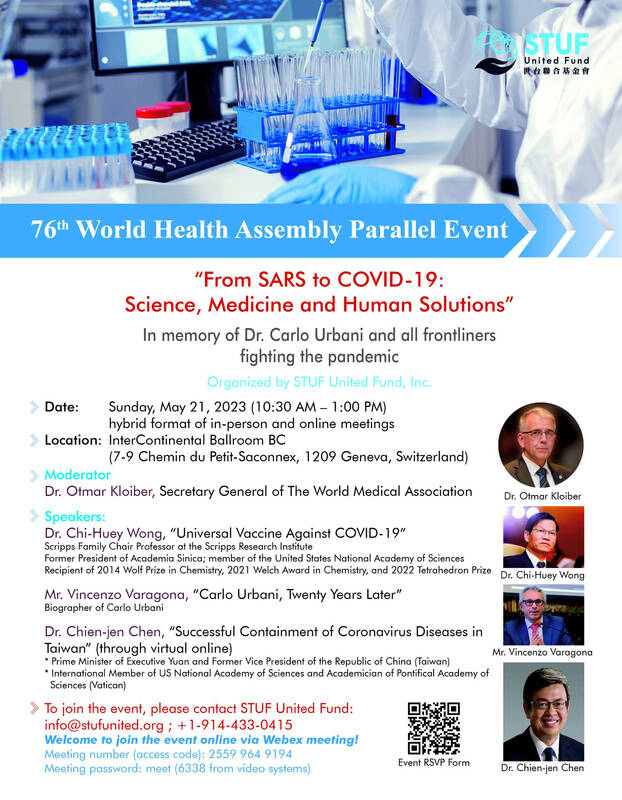Low-sugar vaccination — a recent development in next-generation vaccines — would be safer and more effective than current vaccines, former Academia Sinica president Wong Chi-huey (翁啟惠) said in an interview.
Wong made the statement in a news release ahead of a parallel event to be held by nonprofit charity the STUF United Fund at the 76th World Health Assembly meetings in Geneva, Switzerland, tomorrow.
Wong’s “pioneering work in glycoscience — the study of complex sugars and their role in physiology and disease biology, have already gained international recognition,” STUF chief supervisor Danny Chen (陳啟耕) said.

Photo from the STUF United Fund’s Facebook page
Driven by the need to constantly update COVID-19 vaccines as new variants of SARS-CoV-2 emerge, Wong said his work is focused on creating a “universal vaccine,” and he believes new research on carbohydrates and glycoproteins would benefit that work.
Wong’s lab is dedicated to the development of tools that explain the role that glycosylation plays in the human body, Chen said, adding that Wong’s research has shown how complex sugars affect everything from cancer progression to neurodegenerative disorders.
In the press release, STUF cited research from Wong’s lab that found that SARS-CoV-2 depends on a host-made sugar coat on the spike protein to facilitate infection and evade host immune response.
That process could be manipulated by a vaccine, which would work on all variants of the virus, it said.
Separately, the press release said that Taiwan’s containment of COVID-19 throughout the pandemic could “serve as a gold standard in using science and collective action to reduce needless death and suffering” during a pandemic.
It cited Premier Chen Chien-jen (陳建仁), who will also attend the event, as saying that Taiwan’s successful handling of the pandemic was due to transparent and open policies that built public trust in the Central Epidemic Command Center.
“A nation is only capable of controlling a pandemic when all members of its society are wholly engaged in its containment, through full compliance with the guidance and regulations,” the premier was cited as saying.
Registered in Flushing, New York, the STUF United Fund is focused on humanitarian aid, disaster relief, culture and education, public health and environmental protection.

Three Taiwanese airlines have prohibited passengers from packing Bluetooth earbuds and their charger cases in checked luggage. EVA Air and Uni Air said that Bluetooth earbuds and charger cases are categorized as portable electronic devices, which should be switched off if they are placed in checked luggage based on international aviation safety regulations. They must not be in standby or sleep mode. However, as charging would continue when earbuds are placed in the charger cases, which would contravene international aviation regulations, their cases must be carried as hand luggage, they said. Tigerair Taiwan said that earbud charger cases are equipped

UNILATERAL MOVES: Officials have raised concerns that Beijing could try to exert economic control over Kinmen in a key development plan next year The Civil Aviation Administration (CAA) yesterday said that China has so far failed to provide any information about a new airport expected to open next year that is less than 10km from a Taiwanese airport, raising flight safety concerns. Xiamen Xiangan International Airport is only about 3km at its closest point from the islands in Kinmen County — the scene of on-off fighting during the Cold War — and construction work can be seen and heard clearly from the Taiwan side. In a written statement sent to Reuters, the CAA said that airports close to each other need detailed advanced

Tropical Storm Fung-Wong would likely strengthen into a typhoon later today as it continues moving westward across the Pacific before heading in Taiwan’s direction next week, the Central Weather Administration (CWA) said. As of 8am, Fung-Wong was about 2,190km east-southeast of Cape Oluanpi (鵝鑾鼻), Taiwan’s southernmost point, moving westward at 25kph and possibly accelerating to 31kph, CWA data showed. The tropical storm is currently over waters east of the Philippines and still far from Taiwan, CWA forecaster Tseng Chao-cheng (曾昭誠) said, adding that it could likely strengthen into a typhoon later in the day. It is forecast to reach the South China Sea

WEATHER Typhoon forming: CWA A tropical depression is expected to form into a typhoon as early as today, the Central Weather Administration (CWA) said yesterday, adding that the storm’s path remains uncertain. Before the weekend, it would move toward the Philippines, the agency said. Some time around Monday next week, it might reach a turning point, either veering north toward waters east of Taiwan or continuing westward across the Philippines, the CWA said. Meanwhile, the eye of Typhoon Kalmaegi was 1,310km south-southeast of Oluanpi (鵝鑾鼻), Taiwan’s southernmost point, as of 2am yesterday, it said. The storm is forecast to move through central